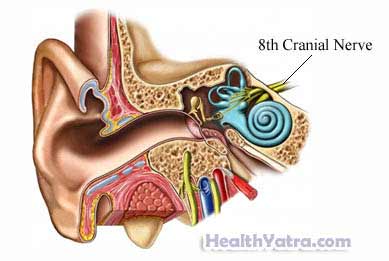Definition
A cochlear implant is an electronic device that is implanted during surgery. It helps provide hearing to people who have a certain type of hearing loss. This type of hearing loss is usually caused by damage or a defect in the inner ear. The implants can directly stimulate the auditory nerve to send information to the brain.
Cochlear implants have three parts:
- Speech processor—The speech processor looks like a long, narrow calculator. It is worn behind the ear or on a belt. It increases sound, converts it into digital signals, and sends these signals to the transmitter.
- Transmitter—The transmitter is a headphone that is worn behind the ear. It receives electrical signals from the speech processor and sends them through the skin to the receiver.
- Receiver—The receiver is the part that is implanted. It is a magnetic disk about the size of a quarter. It is placed under the skin behind one ear. A wire that runs from the receiver to an electrode is placed in the inner ear, where it stimulates the acoustic nerve.

Reasons for Procedure
Cochlear implants provide a heightened sense of sound for adults and children with profound hearing loss. They are designed for people whose hearing does not improve with surgical correction or the use of a hearing aid. Cochlear implants will not restore or create normal hearing.
Possible Complications
If you are planning to have an implant, your doctor will review a list of possible complications, which may include:
- Infection
- Damage to nearby nerves
- Problems with balance
- Emotional stress caused by having higher expectations for the technology
- Poor quality of hearing following the surgery
Some factors that may increase the risk of complications include:
- Smoking
- Previous surgery
- Previous ear infections
- Abnormal anatomy
What to Expect
Prior to Procedure
Your doctor may do some or all of the following.
- Your doctor will examine you, paying particular attention to your ears. This can be done with:
- A medical history and physical exam
- Ear exam
- Hearing evaluation
- Psychological evaluation
- Your doctor may need pictures of your ear. This can be done with:
- MRI
- CT scan
- You should be up-to-date on immunizations. Pneumococcal, meningococcal, andhaemophilus vaccines are especially important. There has been a link between cochlear implants and bacterial meningitis.
Leading up to your procedure:
- Talk to your doctor about your medicines. You may be asked to stop taking some medicines up to one week before the procedure, like:
- Aspirin or other anti-inflammatory drugs
- Blood thinners, such as clopidogrel or warfarin
- Arrange for a ride to and from the procedure.
- The night before, eat a light meal. Do not eat or drink anything after midnight.
Anesthesia
General anesthesia is used for this procedure. You will be asleep.
Description of Procedure
There are two parts to the procedure:
- Implantation of receiver—A cut will be made in the skin behind the ear. A hole will be drilled through the bone behind the ear to the cochlea. A wire will be placed through the hole and into the cochlea. The receiver will then be put against the bone behind your ear. The wire will be attached to the receiver. The incision will be closed with stitches.
- External hook-up—In 4 to 6 weeks, the area should be healed. At this point, the transmitter headpiece and speech processor will be hooked up.
How Long Will It Take?
About 1½-2 hours for adults and up to five hours for children
How Much Will It Hurt?
Anesthesia prevents pain during the procedure. You will have some pain after. Your doctor can give you medicine to help manage any pain.
Average Hospital Stay
The length of stay depends on the reasons why you are having the implant. Speak to your doctor about how long your stay may be.
Post-procedure Care
At Home
After your procedure, be sure to follow your doctor’s instructions. Ask your doctor about when it is safe to shower, bathe, or soak in water.
You will have frequent follow-up visits for the following:
- Headpiece fitting, done 4-6 weeks after surgery
- Adjustments to the speech processor
- Ongoing evaluation of hearing status
In addition, you will have cochlear implant training. This will help improve your ability to:
- Identify sounds
- Read lips
- Develop speech skills
Call Your Doctor
After you leave the hospital, contact your doctor if any of the following occurs:
- Pain
- Dizziness or vomiting
- Facial paralysis or twitching
- Signs of infection, including fever and chills
- Redness, swelling, increasing pain, excessive bleeding, or discharge at the incision site
- Cough, shortness or breath, chest pain, or severe nausea or vomiting
In case of an emergency, call for medical help right away.
